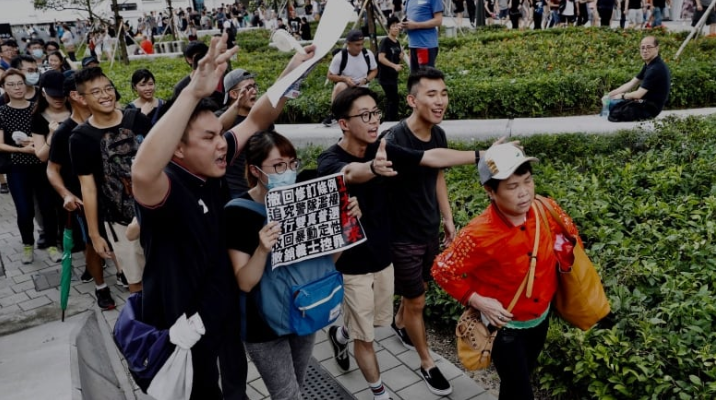March takes them to rail station that connects to mainland destinations.
Thousands of people, many wearing black shirts and some carrying British flags, were marching in Hong Kong on Sunday, targeting a mainland Chinese audience as a month-old protest movement showed no signs of abating.
Chanting “Free Hong Kong” and words of encouragement to their fellow citizens, the demonstrators streamed through a shopping district popular with mainland visitors to the high-speed railway station that connects the semi-autonomous region to Guangdong and other mainland cities.
Hong Kong has been riven by protests for the past month, sparked by proposed changes to extradition laws that would have allowed suspects to be sent to the mainland to face trial. Hong Kong leader Carrie Lam suspended the bill and apologized for how it was handled, but protesters want it to be formally withdrawn and for Lam to resign.
March organizer Ventus Lau said the purpose of Sunday’s protest was two-fold: to reiterate the protesters’ demands to the government and to give mainland visitors a first-hand look at their movement.
“The information is rather blocked in mainland, we want to show them the true image and the message of Hong Kongers,” he said.
The march was the first major protest since last Monday, when protesters smashed thick glass walls to break into the city’s legislature building and wreaked havoc inside, spray painting slogans on the walls, overturning furniture and damaging voting and fire prevention systems.
Most of the marchers were young, wearing black shirts that have become the uniform of the protesters. But the crowd also included older people carrying hand-held fans in the muggy heat, as well as parents with children, including some in baby strollers.
Many were carrying posters, including one that read “Extradite to China, disappear forever.” Some in the crowd were also carrying British flags.
The proposed extradition legislation has raised concerns about an erosion of freedoms and rights in Hong Kong in recent years. The city was allowed to keep its own legal system, based on British common law, for 50 years after Britain returned the then-colony to China in 1997, but many fear that freedom of expression and other rights are under threat.
Prior to the start of the march, police put up large barricades blocking a main entrance to the railway station to prevent any attempt to enter it. Only passengers with train reservations would be allowed into the station, the mass transit authority said, and Hong Kong media reported that ticket sales had been suspended for afternoon trains.
The high-speed railway station, which opened last September, was a source of contention, as passengers pass through Chinese immigration and customs inside. Some opposition lawmakers said the fact that Chinese law applies in the immigration area violates the agreement giving Hong Kong its own legal system.
The July 1 break-in at the legislature overshadowed a peaceful march the same day by hundreds of thousands of people also opposed to the extradition legislation.
Protesters also are demanding an independent investigation into a crackdown on demonstrations June 12 in which officers used tear gas and rubber bullets to disperse crowds blocking major city streets. The tactics used were harsher than usual for Hong Kong, though police have said they were justified after some protesters turned violent. Dozens were injured in the clashes, both protesters and police.
The protesters are also calling for direct election of Hong Kong’s leader. Lam was chosen by an elite committee of mainly pro-Beijing electors.

